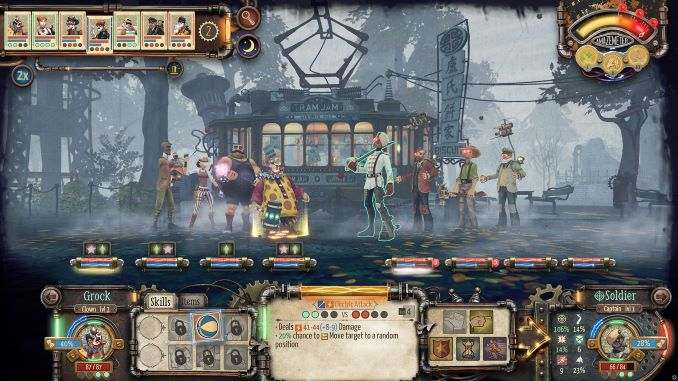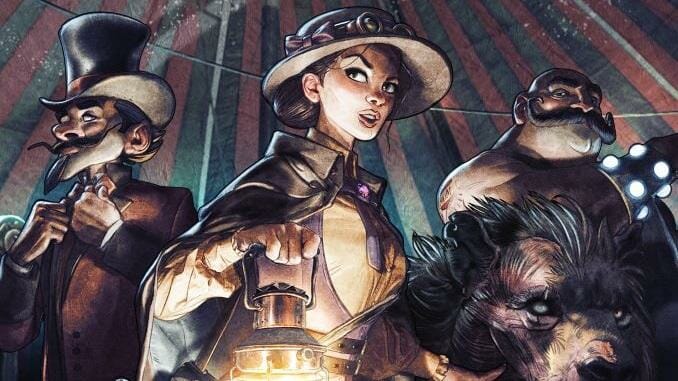According to its own introduction, the 1868 dime store novel The Steam Man of the Prairies is the first American sci-fi pulp novel. Its main character, a disfigured 15 year old boy, creates a mechanical man and takes it on a series of adventures in what is also considered the first “Edisonade,” a genre of “genius inventor” story named for Thomas Edison, who was 21 and not yet an inventor when the novel was published.
Circus Electrique, which takes The Steam Man of the Prairies as one of its inspirations, is its own kind of Edisonade, though its story is more interested in where innovation and technology go horribly wrong. It is an upcoming RPG and management sim hybrid set in a steampunk version of London, where rival circuses fight for supremacy while a more nefarious plot brews in the background. Developers Zen Studios were inspired by Darkest Dungeon, an ultra-difficult RPG focused on party placement where your characters can acquire permanent negative status effects. They aimed to make Circus Electrique more accessible in terms of its difficulty, as well as set it in a non-fantasy setting.
The game is set in Victorian London, in a universe that diverged from ours when the Spark, an electrical accident, made a crowd of people go insane and turned everyday citizens into vicious monsters. The game’s antagonist, an entrepreneur and rival circus leader called Eli Edwards, has established his company STEEM as a cornerstone of the London economy, and is trying his best to put the titular Circus Electrique out of business while also advancing his mysterious goals. The narrator is a journalist who decides to investigate and report on Edwards after an accident where a mechanical man he’s made goes haywire. Working with her uncle, who runs the Circus Electrique, she assembles a team of performers to fight against the rival circus.
Play primarily involves working your way through six neighborhoods of London to solve the mystery of Edwards’ intentions. The combat map in Circus Electrique is laid out much like the map in Slay the Spire, a series of nodes you move through that have battles, events, or treasure chests. Each map is based on a district in this alternate London, and I played through Southwark, the first and only map in the demo Zen Studios provided.
Combat is where comparisons to Darkest Dungeon really come though. There are up to four characters in a line on each side, each of whom has a preferred position. Like in Darkest Dungeon, movement is a key element of combat. Enemies can move your characters from key positions into unfavorable ones where they can’t perform certain moves, and you can do the same to them. There is no MP cost for casting spells or acting; you just perform one action per turn. Instead, you have a morale system called Devotion, which determines a character’s effectiveness when fighting. High Devotion gives you higher damage, while low Devotion makes characters likely to flee. The same is true for your enemies; you can make them flee by reducing their Devotion to zero. I found myself going for health damage almost every time, but I can see where Devotion damage will be essential against harder enemies.

On Normal difficulty I initially found my characters taking no damage most of the time, but the difficulty ramped up quickly. By the time I reached the end of the first area I was taking full advantage of the system for swapping out party members between battles. The character system is also inspired by Darkest Dungeon: there are 15 classes of circus heroes you can use in your party, from fire breathers to cannonball operators. You can purchase new heroes at your camp, and unlike in Darkest Dungeon, can swap between them freely after each battle is done. I thought this was in order to create self-managed difficulty—to give players having a hard time the ability to heal their characters often—and maybe it is, but I found myself using it constantly.
Combat is very reliant on debuffs, both for you and your enemies. As someone who rarely uses debuff abilities, even simple ones, I found myself needing them to get through every fight; some weaken or stun your enemies, others lower their attack, and still others give chip damage. In the second half of the demo, when things really started to get harder, I often found myself stunlocked by something for multiple turns in a row. The worst culprit was the taunt ability, which lasts two turns, can be recast indefinitely, and leaves you unable to attack stronger enemies—giving them time, in one case, to wipe my party.
Every two event nodes, or every in-game day, you go back to your hub and rest and swap out performers, and recruit new ones if you want to. The hub was my favorite area in the game, a dynamic scene with a train running through and little cosmetic changes each time you upgrade the circus. Upgrading this hub is one of the gameplay loops; you get exp to increase your “circus level,” food and items to run it, and other things to help you out while you’re in the field.
You also run a circus show each time you return to camp. This involves balancing the chemistry of different characters (how well they work together) as well as their devotion in order to get the highest possible score and put together the best show. Any characters not in your active party can participate in the circus show, and will earn experience for the privilege. The shows can also help you get items and raise your fame, or the notoriety of your circus, helping to further upgrade it.
At present, the balance between battles and managing circus shows is uneven. It’s distracting to be physically removed from the map every two events and be told to run back and plan a show. However, this is a loop the game depends on; if you can’t swap out characters at will, battles won’t work the same way, and if you can’t give inactive characters passive experience, you’ll end up with uneven teams. I’m not sure how the problem will be solved in the full release, but even in the demo the constant running back and forth interrupted the experience for me.
While the gameplay loops are functional and most of them are balanced well, there are times when the level of micromanagement the game requires begins to feel like a chore. Zen Studios has clearly put a lot of resources into making their setting feel like Victorian London. The expressive character models, film-strip overlays that give cutscenes a retro look, and the characterful hub area all give this alternate London a level of charm. Still, this can’t paper over the fact that Circus Electrique feels very similar to its source material, without the brutal difficulty, but with a level of challenge that fluctuates greatly and requires, at least in the demo, a lot of effort to navigate correctly. The pitch is intriguing, the gameplay sounds good on paper, but for now there’s more work to do before this circus can dazzle its audience.
Emily Price is an intern at Paste and a columnist at Unwinnable Magazine. She is also a PhD Candidate in literature at the CUNY Graduate Center. She can be found on Twitter @the_emilyap.

